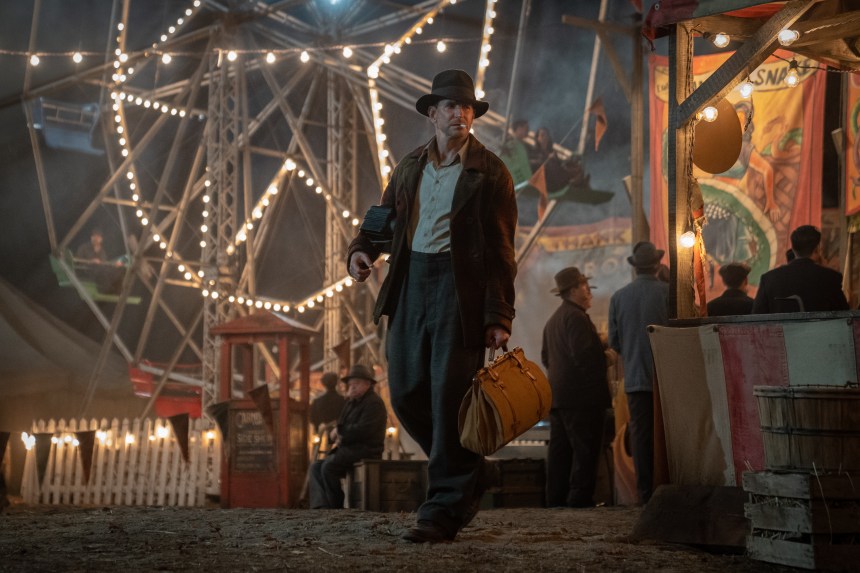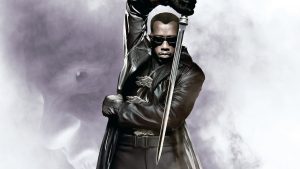
THE LIES WE WEAVE,
THE TRUTHS WE DECEIVE
Amongst the various famous directors out there (i.e. Stephen Spielberg, Christopher Nolan, Ridley Scott, Sam Mendes David Fincher, etc.) known is more visually stunning and mystifying in his directorial works than director Guillermo del Toro. Fascinated with the world of cinema at a young age, del Toro would eventually an interest in make-up and special effects and then created his own company, Necropia. In time, del Toro would eventually come around to directing, with his first directorial feature film debut of the movie Cronos in 1993. From there, the Spanish director would direct his sophomore film Mimic in 1997 (under Miramax studios), which propelled the director forward in his career by producing such recognizable films such as Blade II, Hellboy (and its sequel film Hellboy: The Golden Army), Pan’s Labyrinth, Pacific Rim, Crimson Peak, and The Shape of Water. Throughout his work, del Toro’s work has been characterized with a strong influence / connection to the elements of both horror and fairy tales, with an effort to infuse visual aesthetics or poetic beauty in the vile grotesque. He has had also had a lifelong fascination with creatures and monsters, which he considers symbols of great primordial power and why many such beings have been supplanted within his theatrical motions pictures. Del Toro was also included in Time magazine list of the 100 most influential people in the world in 2018 as well as receiving several nominations and awards for his movies as well as motion picture star on the Hollywood Walk of Fame in 2019. Now, director Guillermo del Toro and Searchlight Pictures present the latest film from the creative and influential mind of del Toro with the release of Nightmare Alley; based on the 1946 novel of the same name by William Lindsay Gresham. Does this newest feature film stand tall and proud in the director’s catalogue of motion picture endeavors or is it something that is too ambitious and different for this “creature and feature” director?

THE STORY
In 1939, Stanton “Stan” Carlisle (Bradley Cooper) is a man on the run, hiding from his past, and crossing the country as a wander before coming across a traveling carnival offering odds and ends small jobs, with ringmaster Clement “Clem” Hoatley (William Dafoe) learning to trust the stranger. Stanton soon becomes a part of the carny family, getting close to mentalist Zeena Krumbein (Toni Collette) and her drunk husband, Peter “Pete” Krumbein (David Strathairn), who’s in possession of a special book detailing the intricate steps of reading marks and working with key codes. Sensing an opportunity, Stanton finds a way to snatch the coveted book, escaping the carnival with sideshow performer, Mary Elizabeth “Molly” Cahill (Rooney Mara). Years later, the pair has made fresh star in the big city with a nightclub show that grows in popularity, with Stanton working his talented grifting skills as a mentalist. After one of their shows, the young man comes across one Lilith Ritter (Cate Blanchett), a psychiatrist who is impressed with Stanton’s skills and who holds key information about her patients intimate secrets. Meeting with the mysterious and cautious woman, Stanton attempts to charm Lilith, seeking help with a plan to con powerful men in the city, including Ezra Grindle (Richard Jenkins), whose willing to give away his fortune for a connection to the other side. As Stanton schemes of a way to play his mark, danger begins to unfold as disaster awaits just around the corner.

THE GOOD / THE BAD
Being a fan of movies (in general), I do have some favorite movie directors that I enjoy watching. Naturally, some of the more bigger named ones such Nolan, Spielberg, Scott are some of the more iconic ones that make waves and generate a lot of “buzz” whenever a new project of theirs gets announced / released. That being said, I do have to admit that Guillermo del Toro is a fantastic director, with a very distinct passion he displays throughout most of his feature films. Perhaps one of the most interesting aspects that del Toro does with most of his production is the usage of practical special effects as seeing in Hellboy, Pan’s Labyrinth, and The Shape of Water, with attention to detail of attraction to creatures and monster designs. He has utilized CGI effects for such monstrous looks and appearance like in Pacific Rim and Hellboy: The Golden Army, but even those are merely to enhance such visual standpoints of creature design that practical effects could not achieve. In addition, I do love how del Toro weaves in elements of fantasy and horror together through several of his movies; interjecting the fanciful and grotesque into a cinematic narrative that’s both beautiful and haunting at the same time. To me, my personal favorite del Toro would have to Pan’s Labyrinth, which (again) incorporates a lot of the practical special effect flourishes as well as balancing classic fairy tale-esque story with a dark touch of horror. I mean…. the infamous “pale man” scene…. that’s stuff of nightmares and wonderfully done! In short, while he might not be a household name or produced as large collection of theatrical films under his belt, director Guillermo del Toro has certainly made a name for himself by crafting well-made movies that have touches of thematic elements and of signature styles of his personal taste and directorial aesthetics.
This brings me back to talking about Nightmare Alley, a 2021 neo-noir psychological thriller that is based on the 1946 book of the same name by author William Lindsay Gresham. I do actually remember hearing about this project a year or two ago when del Toro announced that his next film would be based on the novel titled Nightmare Alley. Given that particular title, I figured that it was going to be another one of his “creature feature” film endeavors…. of which I’m always down to seeing. However, when I saw the film’s first movie trailer for the upcoming movie, I was a little bit taken aback, with the preview showcasing more of a human style cinematic tale rather than a monstrous creature. Of course, the trailer hinted at that notion, but it seemed a bit different. I then learned that this was the second film adaptation of Nightmare Alley by Hollywood, with the 1947 movie, which starred Tyrone Powers in the lead role, being the first. I did stay away from reading much of the synopsis of the 1947 feature as I wanted to be a bit surprise with the 2021 project. Going back to the film’s movie trailer, it definitely looked like a del Toro picture, with dark and moody atmosphere as well as a recognizable cast (i.e. Cooper, Blanchett, Mara, Dafoe, etc.). So, I was definitely interested in seeing Nightmare Alley sometime when it got released on December 17th, 2021. Unfortunately, due to my work schedule for the holiday season and trying to get done a few other movie reviews, I didn’t get the chance to see the film until a few weeks after its theatrical release (mid-January) as well as delaying my review for it until I was on vacation (when I had a lot of free time) at the end of the January. Well, now…. I finally have the chance to give my personal thoughts on the feature. And what did I think of it? Well, I liked it. With the project having a stellar cast and an impeccable presentation, Nightmare Alley is both an ambitious and ambiguous movie from Guillermo del Toro that’s shrouded in mystery and its neo-noir aesthetics, yet to lingering too long and feeling something missing in the process. It’s by no way means a terrible movie and is something I would personally recommend, but I think that del Toro’s ambition is a bit too much and excessive.
As mentioned, I am aware that Nightmare Alley is based on the novel by William Lindsay Gresham as well as having another film adaptation been made in 1947. That being said, I didn’t have the chance to read Gresham’s original book nor see the 1947 film. Thus, my review for 2021’s Nightmare Alley is solely going to be on the movie itself and not on what was added, changed, or removed.

With Guillermo del Toro at the helm, Nightmare Alley is a very ambitious project to tackle, with the director approaching Gresham’s material with a sense of bringing out the story’s neo-noir format of storytelling; something the tale of Gresham’s novel is steeped in. Because of this, movie definitely has that flourishes of neo-noir variety, with del Toro relishing the chance to produce such a movie with such vigor of visual aesthetics. It’s definitely an interesting concept as del Toro usually has with a wide variety of different style genres in his directorial work (i.e. a fairy tale in Pan’s Labyrinth, a subtle superhero tale in Hellboy, Japanese anime / Godzilla kaiju features in Pacific Rim, etc.), with the director crafting his film adaptation of Nightmare Alley by drenching in a sinisterly fun shadowy cinematography and neo-noir references of the 1940s era. I’ll mention more of this in the presentation portion of my review, but it’s worth to say that del Toro gives this movie a sort of “love letter” to that particular subgenre of films and I believe he succeeds.
As mentioned above, del Toro has always had an attraction and overall fascination with monsters and creatures, which are usually incorporated into his cinematic storytelling. Nightmare Alley is a slight departure from that bestiary affinity, with the director showcasing more of a human focus narrative, which I do have to say is quite impressive from del Toro and quite the ambition to craft. Because of this, del Toro makes Nightmare Alley be more of human character focus, with many dealing with deception, desire, and trickery. Then again, the film definitely showcases a person’s inner demons through their actions; projecting the symbolism and manifestations of del Toro’s fascination with monsters. A kind of “beast” found within a every person. So, there is a little bit of the director’s creature flavor to be found in the movie…. just represented in a somewhat different light. Additionally, the movie’s screenplay, which was penned by del Toro as well as Kim Morgan, is quite interesting; utilizing Gresham’s story to shape a feature’s narrative that has plenty of noir storytelling beats of an old Hollywood movie, but cast mysterious light on the various characters throughout the movie. This creates a very “old detective-esque” vibe, with the first half of the movie showing Stanton’s somewhat origins as he learns the tricks of his trade, while the second half presents a slightly more mature iteration of him in a use of skills. To be fair, the main plot of the movie seems to be in the latter half, which creates a little bit of a unbalanced feeling in the movie altogether (more on that below), but del Toro still provides plenty of atmospheric delight and thematic imagery in the first half, which (to me personally) is a bit more visually interesting. Overall, I believe that Nightmare Alley, despite its faults, is an ambitious project that del Toro tackles that is a step forward in the director’s accomplishments of cinematic storytelling as well as the growth of his filmmaking aesthetics that he’s known for displaying.
In the presentation category, Nightmare Alley is incredible to look and perhaps one of the best aspects that the movie has to be praised for. Well, the cast and the acting is terrific as well, but visual look and feel of the film is exquisite and beautiful to behold. With the movie’s backdrop setting being set in both the late 1930s and early 1940s, the film encapsulates the time period fantastically, with a production design working in the feature’s favor as if the background is a character unto itself. As mentioned above, the movie’s neo noir visual aesthetics is translated in a visually stunning way from the darkly decrepit / worn down feeling carnival life in the Midwest to the lavishing urban city life of New York City. Even the various set decorations and costume attires (for both men and women) are amazing to see, with del Toro and his major key “behind the scenes” players, which includes Tamara Deverell (production designs), Brandt Gordon (art direction), Shane Vieau (set decorations), and Luis Sequeira (costume designs) crafting and cultivating a classic Hollywood movie feel that is solid all the way around. In addition, the entire hair / make-up team should be recognize for their efforts, with the various hairstyles, facial hair, and make-up workings looking marvelous to see, with some actors / characters looking that they were plucked out of a 1940s style era. Aiding in the background setting presentation, the film’s cinematography work by Dan Laustsen, which works wonders with his cinema camera wizardry by usage of various photography angles, shadowing effects, and light usage to bringing the neo-noir touch throughout the entire film; generating a great atmospheric mood in Nightmare Alley. Lastly, the film’s score, which was composed by Nathan Johnson, reflects the feature’s visual appeal by providing some great underscoring mood music in various scenes and overall solid music composition for the motion picture.

Unfortunately, Nightmare Alley does have its fair share problematic areas the feature stumbles upon as the film’s narrative progress. How so? Well, for starters, the movie feels long…. longer than it should be. With a runtime of 150 minutes (two hours and thirty minutes), the movie’s duration is quite long and bloated; causing a cinematic excess to proceed throughout the course of the story being told. This, of course, makes the feature feel longer than it should be, with Nightmare Alley being presented as a, more or less, slow-burner endeavor. Don’t get me wrong…. I do love a good slow-burner picture; allowing the film’s plot to slowly unfold and reveal itself at its fullest extent by the time the movie ends is a wonderful cinematic experience to view. Unfortunately, del Toro struggles within this particular aspect by allowing the film to have such a lengthy runtime to tell its story as well as having a more loose feeling in a few pocket areas. This creates several pacing issues that are scattered throughout the film’s narrative, with a sense of sluggish / slow pace at various points. To be sure, Nightmare Alley certainly does have an interesting story to tell and a lot to unpack throughout its two distinct parts. However, del Toro lingers a bit too much on certain aspects and story threads. This is most notable in the carnival community in the first half, which is terrific and has great atmospheric tones, but drags on more than it should. In contrast, the second half, which is set several years later, could’ve benefited a bit more if del Toro allowed more time to let this part of the feature’s narrative to be expanded upon, especially in several plot thread elements and character development. A prime example of this is in the character of Molly in the latter half of Nightmare Alley, with the screenplay having a difficult time to place her in this portion of the story. Overall, I think that Nightmare Alley is both overstuffed and bloated at same time, which causes the film to have a sluggish pacing as well as superfluous elements peppered across the movie.
In addition, Nightmare Alley is predictable in its story. Of course, I do understand that the film’s screenplay by del Toro and Morgan has to follow the original source material from Gresham’s novel. That being said, even without reading the book or even the 1947 movie, it’s clear to see where the movie is heading and how the several twists and turns will play out. Naturally, the big final twist is good and definitely works, but one can easily surmise a lot of the feature’s storyline threads, which makes Nightmare Alley slightly formula. All the visual representation, production designs, and cast help elevate that point, but the predictable nature of it all can’t be fully masked. Due to all of this, Nightmare Alley almost feels like it runs out of steam by the time the feature reaches its conclusion. The end is still satisfying, but doesn’t have a rousing climatic finish as something I was expecting nor what del Toro and his team were striven towards. Basically, what starts out as a promising beginning kind of becomes less tight as the movie continues forward; ending more on a broader scope rather than a singular point of interest to zero in on. I don’t know…maybe it’s just me…. but I just felt like the story out away from itself, with the feature losing its momentum a bit during the climatic portion of the third act.
What definitely helps look past those points of criticisms is in Nightmare Alley’s cast, which I do have to admit is incredible ensemble, a collection of notable actors and actresses that are definitely up to the task in making the story’s dubious characters come to life. Whatever fault that the movie has, no one can deny the terrific cast involved on this project. Headlining the film is actor Bradley Cooper as the film’s central main protagonist Stanton “Stan” Carlisle. Known for his roles in American Sniper, The Hangover, and A Star is Born, Cooper has certainly have made a name for himself in Hollywood, slowly transferring himself from a supporting man to a leading man in motion pictures; finding his acting talents evolving and becoming more expressive. In Nightmare Alley, Cooper gets to show a slightly more darker side to his character acting, with his portrayal of Stanton having a dabble sinister “plots within plots” machinations mindsets, which is presented masterfully. Cooper still has that charismatic swagger about him (of which most of his character roles have), but the film allows the actor to showcase a much more complexed character with wavering methods. There is certainly depth found within Stanton and I think Cooper captures those nuances perfectly.

Similarly, actress Cate Blanchett turns a deliciously fun character performance as Dr. Lilith Ritter, a gracefully poised physiatrist whose ulterior motives align with Stanton’s schemes. Known for her roles in Carol, Blue Jasmine, and The Lord of the Rings: The Fellowship of the Ring, Blanchett has always been a great actress; choosing a wide variety of roles (both major and minor) for her to play, with most finding some type of intricate detail in their character build or going for a role that has substance. In the case of Nightmare Alley, Blanchett finds juicy character role in Dr. Ritter, with the actress easily playing her part with great effectiveness. Ritter does come in the second half of the feature, but Blanchett makes her mark whenever she’s on-screen; chewing through dialogue lines with devilish glee and moxy; making her performance captivating throughout. Plus, I do have to admit that Blanchett looks stunning throughout the entire film, with every costume attire and hair / make up look impeccable as if she belongs within the feature’s neo-noir time setting of the 1940s era. Just absolutely beautiful and a great casting choice!
Lastly, I would say that actress Rooney Mara would be the third main lead in the movie (behind Cooper and Blanchett) with her character of Molly, a once carny sideshow performer who finds comfort in Stanton’s company and follows him on his grifting ploys. Known for her roles in Carol, The Social Network, and The Girl with the Dragon Tattoo, Mara does a great job in playing up the innocent young woman naivete within Molly at the feature’s first half, which slowly transforms into a more mature (almost slightly jaded) outlook towards Stanton’s decision as the feature progresses. Thus, Mara’s Molly is a interesting character to watch throughout the movie.
Looking past the main leads of the feature, Nightmare Alley does include several other recognizable talents to appear throughout the movie’s story. In the larger supporting character roles, actress Toni Collette (Hereditary and Glassland), actor David Strathairn (Lincoln and The Bourne Ultimatum), and actor William Dafoe (Spider-Man: No Way Home and At Eternity’s Gate) do solid character performance roles as various carnival roles of the mystified psychic reader Madame Zeena, her drunk, yet knowledge mentalist husband Pete, and ringmaster leader Clem respectfully. Also, actor Richard Jenkins (The Shape of Water and Step Brothers) turns a fine performance as Ezra Grindle, a man who is powerful, yet desperate to find someone who can help connect to Great Beyond. All certainly get into their characters extremely well, which is showcased beautifully whenever they are on-screen.
The rest of the cast, including fan-favorite collaborator of del Toro actor Ron Perlman (Hellboy and Sons of Anarchy) as carny member Bruno, actor Mark Povinelli (Water for Elephants and Mirror Mirror) as carny member Major Mosquito, actor Peter MacNeil (This Life and Open Range) as Judge Kimball, actress Mary Steenburgen (Step Brothers and Elf) as Judge Kimball’s wife Felicia, actor Holt McCallany (Wrath of Man and Lights Out) as Grindle’s muscle man Anderson, actor David Hewlett (Stargate: Atlantis and The Shape of Water) as Dr. Elrood, actress Lara Jean Chorostecki (Designated Survivor and Hannibal) as Louise Hoatley, and actor Tim Blake Nelson (The Incredible Hulk and O’Brother Where Art Thou) as Carny Boss, are delegated to minor supporting characters in the movie. A few have a bit larger moments than others, but all these acting talents give solid work in their respective roles and definitely fit into the feature’s time period and visual costume attires.

FINAL THOUGHTS
Is he man or beast? A question pondered for examination as scheming grifter Stanton Carlisle performs his mentalist tricks to escape his past and plunges into a menagerie of dubious impressions and dire consequences in the movie Nightmare Alley. Director Guillermo del Toro latest film spins a very intrigue web of con-artistry and period piece drama; finding a fascination with a more “human-centric” story to tell within the Gresham’s novel source material. While the film falters at being more of a slow burner (along with its excessive runtime and pacing issues), the movie still manages to be a well-crafted production for the acclaimed director, especially thanks to his incredible presentation, a great usage of atmospheric nuances, fantastic costumes, a touch of that classic neo-noir storytelling, and a terrific ensemble cast. Personally, I liked this movie. Yes, the project was a little bit of a departure from del Toro’s usual work, but I love the production presentation and the cast was just stellar all the way around. Although, I kind of wish that the movie was a little bit ironed out better and a had tighter finesse in is shaping and overall execution. Looking beyond that…..it was still a good movie, which is why my recommendation for this feature is a “recommended” as fans of del Toro will still enjoy the film he crafted as well as cinephiles who are looking for neo-noir period piece. In the end, while it may not be the director’s absolute best project to date, Guillermo del Toro’s interpretation of Nightmare Alley is a unique theatrical motion picture that utilizes the director’s atmospheric strengths that, despite a few sluggish points, interlaces period piece aesthetics within human character drama; uncovering the monsters / demons that lies within us all.



